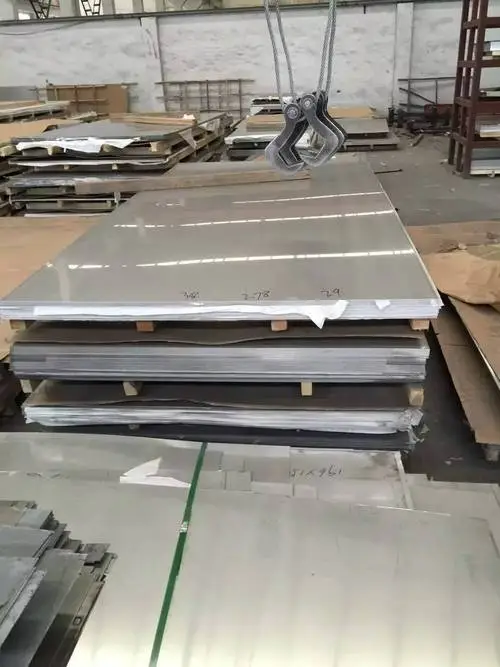
How Stainless Steel Foil Is Made: From Hot-Rolled Coil to Ultra-Thin Precision
Stainless steel foil is a versatile material used in industries ranging from aerospace to medical devices. Its thin, durable, and

Stainless steel sheets, a remarkable material with a blend of strength, corrosion resistance, and aesthetic appeal, have become an integral part of our modern world. But what exactly is a stainless steel sheet, and why has it become so ubiquitous across various industries? This article delves into the what is stainless steel sheet, exploring the historical evolution, scientific underpinnings, role in construction and manufacturing, and innovative future trends of stainless steel sheets. Whether you’re an architect, engineer, hobbyist, or simply curious about the material that shapes much of our daily lives, this comprehensive examination promises to enlighten and inspire.
Stainless steel sheet, a highly valued material in various industries, has a rich and fascinating history. Its creation, attributed to British metallurgist Harry Brearley in 1913, was initially aimed at developing an alloy resistant to gun barrels’ rapid erosion. This transformative discovery revolutionized numerous sectors, particularly architecture, construction, and manufacturing.
Get more: why aluminum foil in dishwasher
Brearley’s unique alloy combined iron, carbon, and a hefty 12.8% chromium. Chromium, a lustrous, hard, steel-gray transition metal, is the magic ingredient that imparts stainless steel with its corrosion resistance.
Read on: yaoyi stainless steel foil
The high resistance to rust and tarnish presented an immediate appeal to various sectors. Stainless steel sheets started making their way into cutlery, military equipment, and construction. It wasn’t long before it became the gold standard for hygiene-sensitive areas like hospitals and kitchens.
During the World Wars, stainless steel sheets played a crucial role. They were used extensively in manufacturing military vehicles, aircraft, naval ships, and weaponry. Their inherent strength and resilience to corrosion were vital in these harsh environments.
After World War II, the material found its way into the civilian sphere at an accelerated pace. Stainless steel sheets were heavily used in construction, appliances, and automotive sectors, transforming the look of modern cities and households.
Today, stainless steel sheets are everywhere. From iconic architectural structures to everyday household items, its applications are wide and varied. Yet, the journey of stainless steel is far from over. With ongoing research, the alloy continues to evolve, meet new challenges and serve our societies.
Understanding the science behind stainless steel sheets helps explain their enduring popularity across industries.
Stainless steel’s corrosion resistance stems from the presence of at least 10.5% chromium. On exposure to oxygen, chromium forms a passive layer of chromium oxide on the steel’s surface. This layer is invisible, adherent, and repairs itself when damaged, protecting the inner structure.
Based on the additional alloying elements and their proportions, stainless steel is classified into five groups: austenitic, ferritic, martensitic, duplex, and precipitation-hardening. Each offers a unique combination of mechanical properties, corrosion resistance, and workability.
Stainless steel is often classified by grades, determined by its compositional ranges. For instance, 304-grade stainless steel, the most common grade, is an austenitic variety containing 18-20% chromium and 8-10% nickel.
Creating stainless steel sheets involves several steps. It starts with the melting and casting of raw materials into slabs. These slabs are then heated and rolled to the desired thickness and finish. The process can vary based on the final product’s requirements.
Stainless steel’s lifecycle reflects a commitment to sustainability. Its high recyclability, long service life, and resource efficiency make it a valuable material in a world increasingly focused on green solutions.
The adoption of stainless steel sheets in construction is a testament to their robustness, versatility, and aesthetic appeal.
Stainless steel sheets have become a staple in modern architectural design. Their sleek finish and adaptability allow architects to create stunning visual impacts. Notable examples include the Chrysler Building in New York and the Petronas Towers in Kuala Lumpur.
Stainless steel sheets provide strength and resilience to structures. Their high tensile strength, coupled with corrosion resistance, makes them an ideal choice for demanding conditions.
Stainless steel sheets offer architects immense flexibility. They can be bent, folded, and molded into intricate designs, enabling a plethora of architectural possibilities.
Stainless steel sheets require little to no maintenance. Their ability to resist stains and corrosion, coupled with their toughness, minimizes upkeep costs, making them a cost-effective choice in the long run.
Construction industries worldwide are under pressure to reduce their environmental impact. The high recyclability and longevity of stainless steel sheets make them a sustainable choice.
Stainless steel sheets have a pivotal role in the manufacturing sector due to their adaptable properties and various application possibilities.
Stainless steel sheets are a favorite in the automotive industry. Their corrosion resistance and high strength-to-weight ratio make them suitable for vehicle parts exposed to harsh conditions, enhancing the vehicle’s lifespan.
In the food and beverage industry, stainless steel sheets are ubiquitous. They are used in processing equipment, containers, utensils, and kitchen appliances. Their non-porous nature prevents bacteria buildup, ensuring food safety.
In the medical field, stainless steel sheets are integral. Used in surgical instruments, implants, and medical devices, they offer a combination of sterilizability, durability, and corrosion resistance.
The aerospace industry heavily relies on stainless steel sheets for their strength, heat resistance, and corrosion resistance. These characteristics are critical in aircraft manufacturing, ensuring passenger safety and aircraft longevity.
In the energy sector, stainless steel sheets find applications in power plants, oil refineries, and renewable energy infrastructure. Their durability and resilience to extreme temperatures and pressure conditions make them an indispensable resource.
The world of stainless steel sheets continues to evolve, with research and innovation driving new possibilities.
One of the most exciting developments in the steel industry is the advent of Advanced High-Strength Steel (AHSS). This new generation of steel offers superior strength and ductility, providing potential solutions to the ever-growing demands of various industries.
Another significant innovation is nanostructured stainless steel. This material exhibits enhanced mechanical properties and corrosion resistance. The potential applications are vast, ranging from automotive components to medical devices.
Stainless steel is making its mark in the world of 3D printing. Combining the strength and durability of steel with the flexibility of 3D printing could usher in a new era of design and manufacturing.
There is increasing pressure on the steel industry to adopt greener production methods. Developments in more energy-efficient and less resource-intensive processes are critical for the industry’s sustainable future.
The concept of a circular economy, where resources are kept in use for as long as possible, aligns well with the high recyclability of stainless steel sheets. They remain a key player in sustainable development, contributing to a greener future.
Through these perspectives, we gain a comprehensive understanding of stainless steel sheets, their history, their role in our world, and their exciting future.
Read more: why foil in dishwasher

Stainless steel foil is a versatile material used in industries ranging from aerospace to medical devices. Its thin, durable, and

Stainless steel foil represents one of the most versatile and technologically advanced materials in modern manufacturing. This ultra-thin, high-performance material